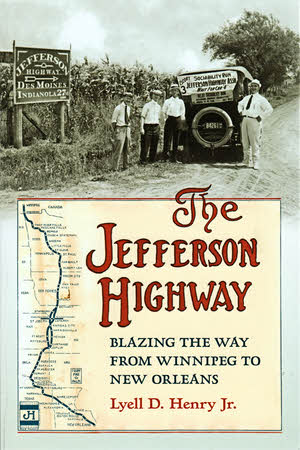 In its preface, Lyell D. Henry Jr. suggests that this book is something of a compromise. The reason is that he once set out to write about every detail of the Jefferson Highway and the association behind it. That’s a lot of details and, especially with no known central source for records or maps, a formidable task. Henry says he “…settled on writing a book that would open with a general accounting of JHA’s early pursuit of the entire highway but then narrow its focus to the highway through Iowa.” The Jefferson Highway: Blazing the Way from Winnipeg to New Orleans is indeed a book of two parts. The first four chapters cover the history of the organization responsible for the entire highway; The last three tell the story and describe the route of the road in Iowa. The scale may be less and the focus may be narrower than what Henry once had in mind but, within that narrowed focus, there is certainly no detectable compromising of accuracy or completeness.
In its preface, Lyell D. Henry Jr. suggests that this book is something of a compromise. The reason is that he once set out to write about every detail of the Jefferson Highway and the association behind it. That’s a lot of details and, especially with no known central source for records or maps, a formidable task. Henry says he “…settled on writing a book that would open with a general accounting of JHA’s early pursuit of the entire highway but then narrow its focus to the highway through Iowa.” The Jefferson Highway: Blazing the Way from Winnipeg to New Orleans is indeed a book of two parts. The first four chapters cover the history of the organization responsible for the entire highway; The last three tell the story and describe the route of the road in Iowa. The scale may be less and the focus may be narrower than what Henry once had in mind but, within that narrowed focus, there is certainly no detectable compromising of accuracy or completeness.
The Jefferson Highway was one of the more significant named auto trails of the early twentieth century. The association promoting it was created in November of 1915 and the highway, like all named auto trails, effectively ceased to be when the Numbered US Highways were established in November of 1926. A modern day Jefferson Highway Association formed in 2011.
The featured players in those first four chapters are men at the top of the Jefferson Highway Association. Men like its founder, Edwin T. Meredith, its first General Manager, James D. Clarkson, and a few others. Likewise, the routeing discussions and decisions presented are those affecting the basic overall course of the highway. Particularly with this being the first book written on the Jefferson Highway in many decades, I thought this a sensible approach. Other leaders and other decisions certainly played important roles in specific states or regions and many that affected Iowa are discussed in the last three chapters. Henry writes that he hopes others will undertake similar projects for the other seven Jefferson Highway states in the near future. When they do, the first four chapters of this book could serve as a foundation. As someone without much knowledge of this highway’s history, I saw them as a sort of JH primer.
The second portion of the book is organized as a north to south driving tour with tales of the various routeings and the points of interest beside them woven into the driving directions. There is no denying that one reason Henry writes about Iowa is that it is his home but it is a very reasonable choice for other reasons as well. JHA founder Edwin T. Meredith was an Iowan and the crossing of the Jefferson and Lincoln Highways at Colo, Iowa, gave the state as good a claim as any to being the “Crossroads of America”.
I’ll readily confess that few of the mileage measurements or specific turning instructions really registered with me as I read those last three chapters but I know they will be invaluable when I someday set out to drive the Jefferson Highway. That doesn’t mean those chapters were boring or should be skipped. Descriptions of the many small towns along the way are certainly interesting and Henry provides quite a bit of road and roadside history, too. An example that I particularly enjoyed was learning, for the first time despite driving through it a few times on the Lincoln, just how Iowa’s “Crossroads of America” escaped becoming the “Cloverleaf of America”.
The book is well illustrated with black and white photographs and drawings. Some of the photos are historic but many, particularly in the three “road tour” chapters are quite recent. A majority of these, though far from all, were taken by current JHA treasurer, Scott Berka.
There were hundreds of named auto trails when numbered highway made them all obsolete. Some were little more than a line on a map and some were outright scams. Without question, the JHA was one of what the outfit responsible for those numbers, the American Association of State Highway Officials, called “reputable trail associations”. It’s good to see it getting some twenty-first century literary attention.
Available through Amazon.
